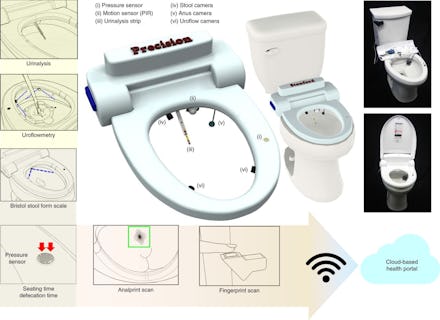This smart toilet can identify your butthole and analyze your poop for diseases

Doctors can tell a lot about a person’s health based on their bowel movements. The waste that comes out of you can hold early signs of disease, including irritable bowel syndrome, kidney failure, and colorectal or urologic cancers. Actually recognizing those indicators might seem like a messy proposition, but researchers at Stanford University have created a concept for a toilet that can analyze your urine and feces to keep tabs on your health. It’s designed for multiple users in a household, and distinguishes between them based on the unique qualities of each person’s butthole.
The way the toilet works is relatively simple, as should be the case with any good commode. As detailed in a research paper published in the journal Nature this week, when a user sits down to go about their business, the throne starts identifying them. It does this by analyzing the "distinctive features of their anoderm," which is the lining of the anal canal. In other words, it uses a camera to check your butthole — or what the researchers call your "analprint." The analysis to determine the users is all done via an "encrypted cloud server," which will maintain pictures and videos of your anus so that the toilet always knows who is about to clear their bowels.
Of course, the real function of the smart toilet comes in its ability to analyze what you dump into it. The researchers equipped the bowl with four cameras, motion sensors, and a whole suite of other testing technology that provides the types of readouts that you'd otherwise have to go to a lab to get.
When you urinate in the toilet, for instance, two high-speed cameras track the flow rate of your stream. The toilet is equipped with a collection of urinalysis strips, which slide out automatically when the toilet detects it’s being used. Once you've soaked the strip, it retracts back into the toilet. (The current version of the toilet was designed for people who can stand when they pee, though future models will supposedly be more comprehensive.) As for poop, a camera activates to capture images of the entire shitting process. Those images are run through an artificial intelligence algorithm that can measure the amount of time it took for you to finish the task, which the researchers state is "significantly correlated with overall bowel function." The camera views using toilet paper or standing up as ending the process, which means if you're using the toilet to secure yourself some alone time, the reading might be off by a bit.
Additionally, the camera will analyze the stool itself for any changes, which it can track over time. That can serve as an indicator of a change in overall health or act as a warning sign to signal that something might be wrong. The process is also built directly into your everyday routine, rather than requiring a person to go to a lab and undergo extensive, expensive testing. According to researchers, "the ideal sources of diagnostic information for continuous health monitoring are the potentially information-rich molecular contents of breath, sweat, saliva, urine and stool."
Before you go racing out to your local Home Depot to pick up one of these smart toilets, you should know that unfortunately it's still in the concept phase — though it has undergone its first series of successful testing. According to the researchers, 21 participants so far have put to use a prototype version, which equips an existing toilet with all of the bells and whistles that will eventually be on the real thing. Sanjiv Gambhir, one of the lead researchers on the project, said the concept is more than 15 years in the making, but it seems that it's finally gaining momentum.